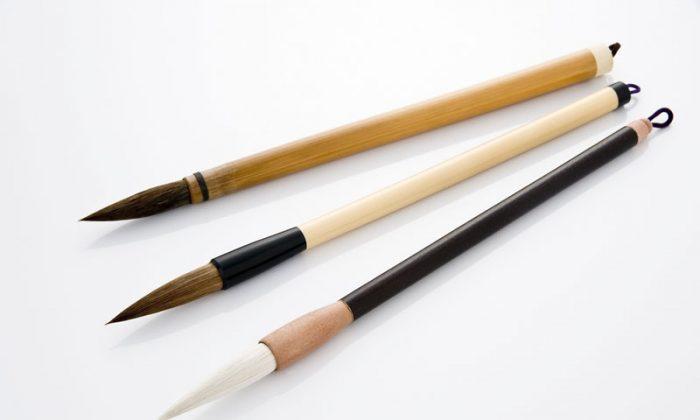Renowned historian Sima Qian (司馬遷) of the Han Dynasty (206 B.C.–A.D. 220) wrote in “Shi Ji” (史記), or “Records of the Grand Historian,” that “Meng Tian (蒙恬) used hair from the mountain hare to make brushes.”
Meng Tian was a high-ranking general during the Qin Dynasty (221–206 B.C.) who distinguished himself in campaigns against invasions by northern nomadic tribes and in the construction of the Great Wall as a defensive wall.
Later generations inherited the saying that “Meng Tian created the brush.” However, in Meng’s time, not only the state of Qin but other states of China also had brushes. The difference was that only the brushes made by Meng were called bi (筆, bǐ), the Chinese name for a writing brush or other writing implement that we know today, while the brushes used in the other states, such as Chu, Wu, and Yan, all had different names.
It was not until Qin Shi Huang (秦始皇) became the first emperor of a unified China that the making and naming of the writing brush became unified.
At that time, however, the skill of making writing brushes had still to be perfected, and brushes were not yet in popular use. Therefore, commoners did not have access to brushes.
There is a story about the writing brush told in the “Collected Biographies of Immortals” (列仙傳), also translated as “Biographies of Exemplary Immortals,” a book traditionally attributed to Liu Xiang (劉向) of the Han Dynasty.
As the story goes, during the reign of Emperor Huan of Han (漢桓帝) (A.D. 132–168), there lived a brush maker called Li Zhongfu (李仲甫). One day, Li took the brushes he had made to the Liaodong market to offer them for sale.
Regardless of whether a customer had money to pay, Li Zhongfu the brush maker gave each person a brush. Thus, it did not take long before all the brushes were gone.
The next day, Li again brought 10 bundles of brushes to the market. His superior skill in brush making quickly became recognized far and wide.
According to the “Collected Biographies of Immortals,” as a youth Li Zhongfu practiced Daoist cultivation as a disciple of Daoist Wang Jun (王君). Before long, Li had already learned many Daoist techniques, including the technique of invisibility. Moreover, when he was over 100 years old, he suddenly became very young in appearance.
When Li first began to learn the technique of invisibility, he was only able to remain invisible for about 100 days. Later, he was able to remain invisible for much longer. When he was having a conversation with another person, the other person would only be able to hear his voice but was unable to see Li himself.
One day, a man who made a living by catching birds cast a net some 500 li from Li’s home. (This distance, 500 Chinese miles, is equivalent to 250 kilometers or 155 miles). The man caught a bird, and later the bird transformed into Li Zhongfu.
After the two men spoke and then bade each other goodbye, Li headed for home. It would take an ordinary man several days to walk 500 Chinese miles, but Li arrived home the same day.
Li stayed in the human world for over 300 years before retreating to the Western Great Mountain, never again returning to the mortal world.
The Western Great Mountain, or Mount Xi Yu (西嶽山), is one of the Five Great Mountains of China, a group of renowned mountains that have great spiritual significance in Chinese history.
Adapted from minghui.org
*Image of “writing brush“ via Shutterstock

Friends Read Free